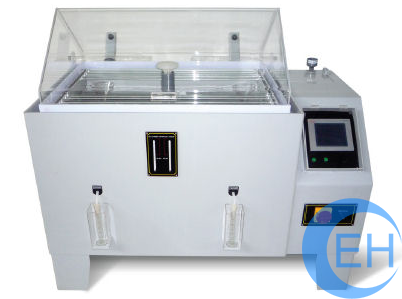Knowledge of Salt Spray Test, The Use of Salt Mist Spray Testing
The salt spray test is a standardized and popular corrosion test method, used to check corrosion resistance of materials and surface coatings. Usually, the materials to be tested are metallic (although stone, ceramics, and polymers may also be tested) and finished with a surface coating which is intended to provide a degree of corrosion protection to the underlying metal. Salt spray testing is an accelerated corrosion test that produces a corrosive attack to coated samples in order to evaluate (mostly comparatively) the suitability of the coating for use as a protective finish. The appearance of corrosion products (rust or other oxides) is evaluated after a pre-determined period of time. Test duration depends on the corrosion resistance of the coating; generally, the more corrosion resistant the coating is, the longer the period of testing before the appearance of corrosion/ rust. The salt spray test is one of the most widespread and long established corrosion tests. ASTM B117 was the first internationally recognized salt spray standard, originally published in 1939. Other important relevant standards are ISO9227, JIS Z 2371 and ASTM G85.

The apparatus for testing consists of a closed testing cabinet/chamber, where a salt water (5% NaCl) solution is atomized by means of spray nozzle(s) using pressurized air. This produces a corrosive environment of dense salt water fog (also referred to as a mist or spray) in the chamber, so that test samples exposed to this environment are subjected to severely corrosive conditions. Chamber volumes vary from supplier to supplier. If there is a minimum volume required by a particular salt spray test standard, this will be clearly stated and should be complied with. There is a general historical consensus that larger chambers can provide a more homogeneous testing environment.
Typical coatings that can be evaluated with this method are:
●Phosphated (pre-treated) surfaces (with subsequent paint/primer/lacquer/rust preventive)
●Zinc and zinc-alloy plating (see also electroplating). See ISO 4042 for guidance
●Electroplated chromium, nickel, copper, tin
●Coatings not applied electrolytically, such as zinc flake coatings according to ISO 10683
●Organic coatings, such as rust preventives
●Paint Coating
Hot-dip galvanized surfaces are not generally tested in a salt spray test (see ISO 1461 or ISO 10684). Hot-dip galvanizing produces zinc carbonates when exposed to a natural environment, thus protecting the coating metal and reducing the corrosion rate. The zinc carbonates are not produced when a hot-dip galvanized specimen is exposed to a salt spray fog, therefore this testing method does not give an accurate measurement of corrosion protection. ISO 9223 gives the guidelines for proper measurement of corrosion resistance for hot-dip galvanized specimens.
Painted surfaces with an underlying hot-dip galvanized coating can be tested according to this method. See ISO 12944-6.
Testing periods range from a few hours (e.g. 8 or 24 hours of phosphated steel) to more than a month (e.g. 720 hours of zinc-nickel coatings, 1000 hours of certain zinc flake coatings).